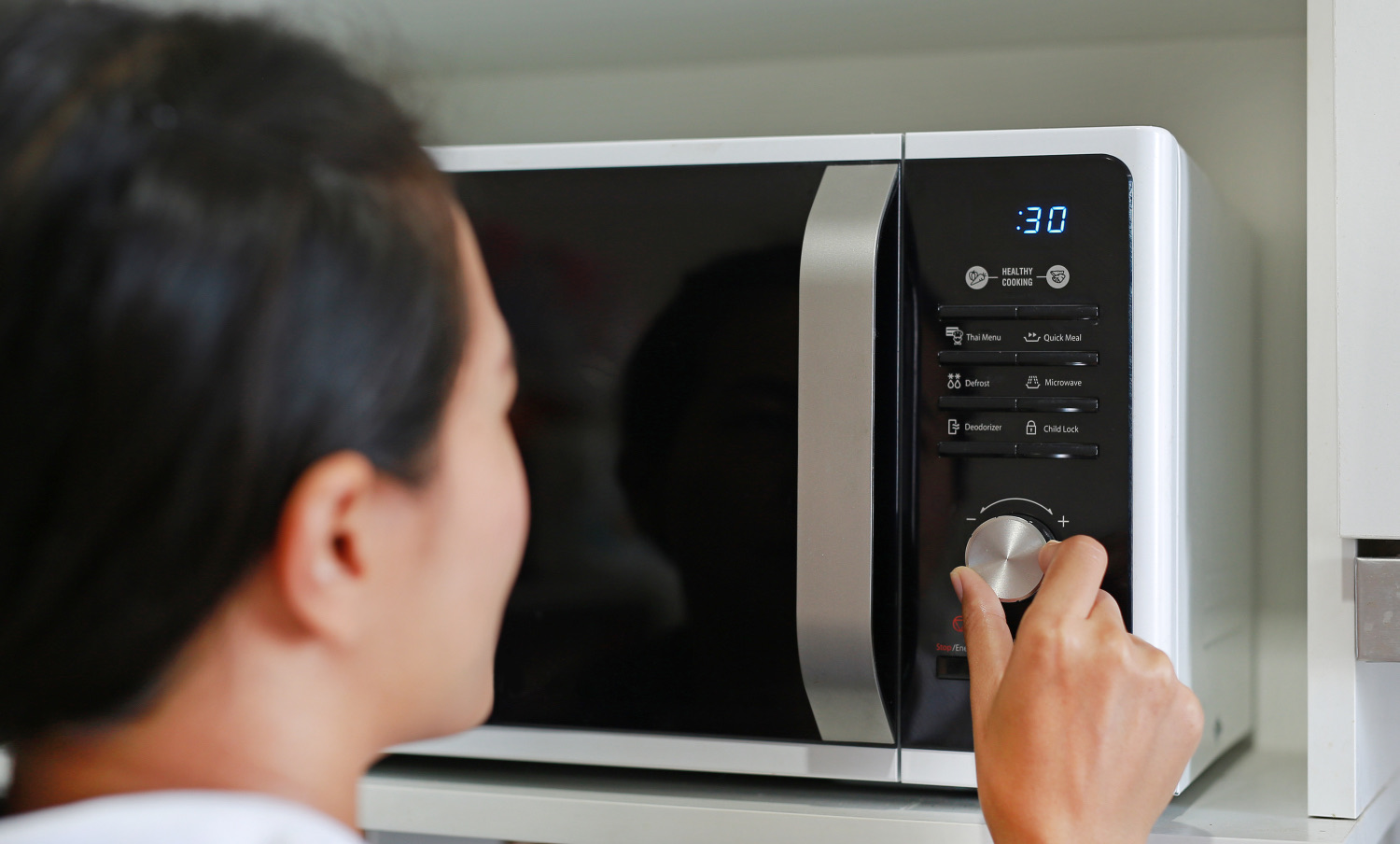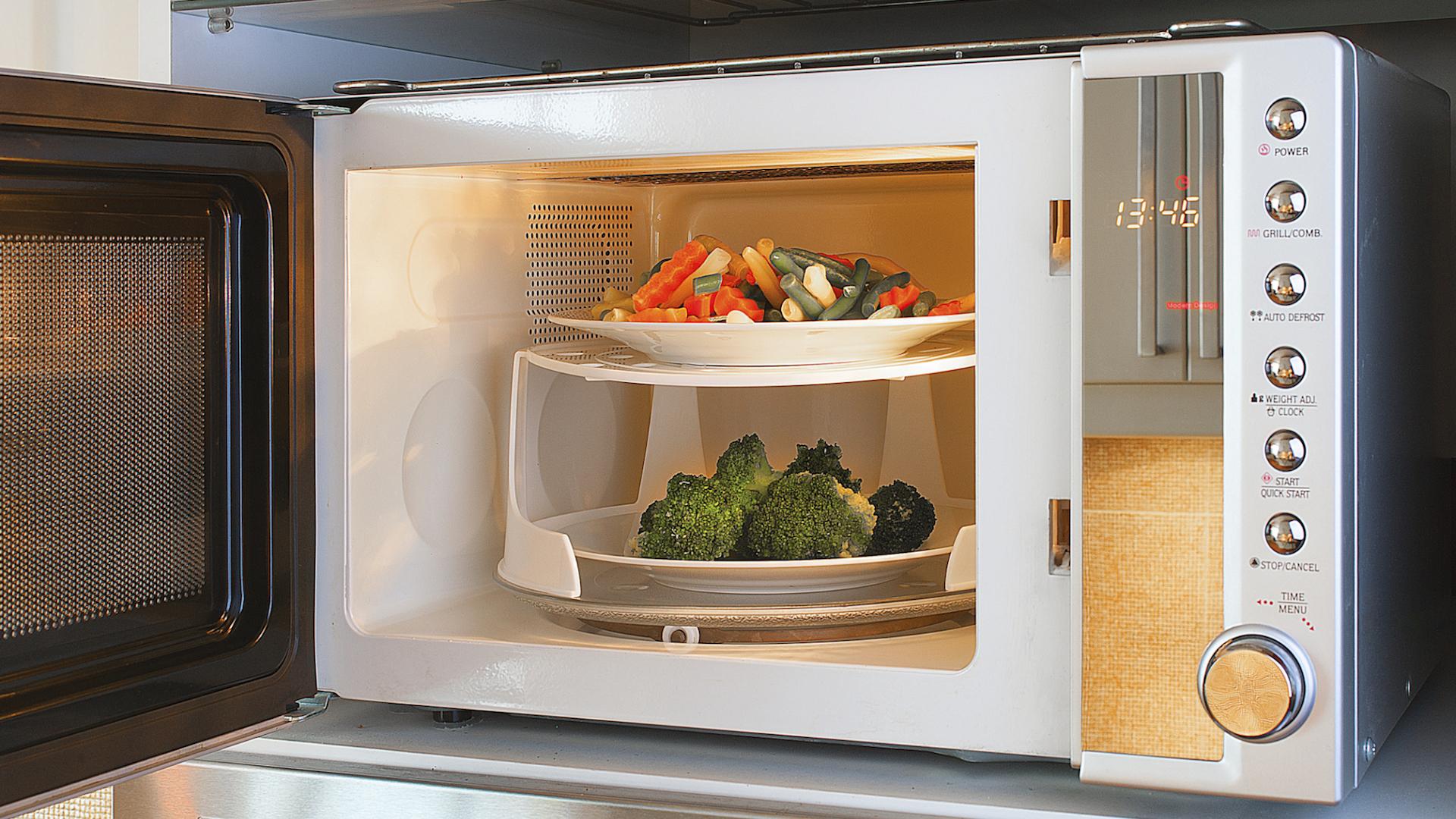Home>Articles>What Is Difference Between Microwave And Microwave Oven


Articles
What Is Difference Between Microwave And Microwave Oven
Modified: March 1, 2024
Discover the key differences between a microwave and a microwave oven in this informative article. Learn how each appliance functions and determine which one is best for your needs.
(Many of the links in this article redirect to a specific reviewed product. Your purchase of these products through affiliate links helps to generate commission for Storables.com, at no extra cost. Learn more)
Introduction
When it comes to heating and cooking food quickly and efficiently, two popular appliances come to mind: the microwave and the microwave oven. While often used interchangeably, these terms actually refer to two different types of appliances with unique features and functions. In this article, we will explore the key differences between a microwave and a microwave oven, from their definitions and components to their functioning and cooking techniques.
Let’s begin by understanding the basic definitions of a microwave and a microwave oven.
Key Takeaways:
- Microwaves are ideal for quick heating and basic cooking tasks, offering speed, convenience, and energy efficiency. However, they may lack browning capabilities and have limited cooking techniques.
- Microwave ovens provide versatility, larger cooking capacities, and the ability to achieve desirable browning and texture variations. While they offer more advanced cooking options, they may require more time, user familiarity, and investment.
Definition of Microwave
A microwave is a kitchen appliance used for heating and thawing food quickly. It uses microwave radiation, a form of electromagnetic radiation, to generate heat within the food. Microwaves work by emitting waves with a frequency range of around 2.45 gigahertz, which is absorbed by water, fats, and sugars in the food.
The waves generated by a microwave cause the water molecules in the food to vibrate rapidly, producing heat. This heat, in turn, cooks or heats the food from the inside out. As a result, microwaves are able to heat food much faster than conventional cooking methods such as stovetop or oven cooking.
Microvaves are typically countertop appliances that are easy to operate and offer a range of cooking functions. They are commonly used for reheating leftovers, defrosting frozen food, and quickly cooking pre-packaged meals. Microwaves are known for their convenience and time-saving capabilities, making them a staple in many households.
Now that we have a clear understanding of what a microwave is, let’s move on to the definition of a microwave oven.
Definition of Microwave Oven
A microwave oven, sometimes simply referred to as a microwave, is a kitchen appliance that combines the functionality of a microwave with a traditional convection oven. In addition to using microwave radiation, a microwave oven also utilizes conventional heating methods to cook, bake, and roast food.
Unlike a standalone microwave, a microwave oven includes heating elements and a fan that circulates hot air within the cooking chamber. This allows for more even and thorough cooking, giving users the option to prepare a wider variety of dishes.
One of the key advantages of a microwave oven is its versatility. It offers users the convenience of a microwave for quick heating and defrosting, while also providing the capabilities of a traditional oven for baking and roasting. This makes it suitable for a range of cooking tasks, from heating up leftovers to preparing complete meals.
Additionally, microwave ovens often come with preset cooking functions and adjustable power levels, allowing users to easily control cooking times and temperatures. This level of control enables more precise cooking, particularly when it comes to delicate or time-sensitive recipes.
Overall, a microwave oven is a multi-purpose kitchen appliance that combines the speed and convenience of a microwave with the baking and roasting capabilities of a traditional oven. It offers users a versatile cooking solution for a wide range of culinary needs.
Now that we are familiar with the definitions of both a microwave and a microwave oven, let’s delve into their historical origins to gain a deeper understanding of their evolution.
History of Microwave and Microwave Oven
The history of microwaves dates back to the early 1940s when Dr. Percy Spencer, an engineer at Raytheon Corporation, made a surprising discovery. While working with magnetrons, a type of vacuum tube used in radar systems, Dr. Spencer noticed that a candy bar in his pocket had melted. He realized that the magnetrons emitted microwave radiation which had the ability to heat food.
In 1945, Raytheon Corporation filed a patent for the microwave cooking process and introduced the first commercial microwave oven, called the “Radarange,” in 1947. This early microwave oven was large and expensive, primarily used in commercial settings such as restaurants and cafeterias.
Over the years, advancements in technology and manufacturing led to the development of smaller, more affordable microwave ovens. In the 1960s, countertop microwave ovens became popular in households, revolutionizing the way people cooked and heated food.
Today, microwave ovens are a staple in kitchens around the world, with various sizes and models available to cater to different needs and budgets. The continuous innovations in microwave technology have led to improved performance, enhanced features, and increased energy efficiency.
On the other hand, microwave cooking without a dedicated oven became widely adopted in the 1970s. The introduction of affordable and compact microwaves made them a common household appliance. Microwaves quickly gained popularity due to their speed and convenience, allowing users to heat or cook food in a fraction of the time compared to traditional methods.
With the advancements in technology, microwaves have become more efficient, providing users with a range of features such as preset cooking modes, sensor cooking, and even combination functions with convection or grill capabilities.
Advancements in microwave and microwave oven technology continue to drive the culinary world forward, offering convenience, speed, and versatility in the kitchen.
Now that we have explored the history of microwaves and microwave ovens, let’s discuss the components of each appliance to better understand their functioning.
Components of Microwave
A microwave consists of several key components that work together to generate and distribute microwave radiation and facilitate the cooking process. Let’s take a closer look at each of these components:
- Magnetron: The magnetron is the heart of a microwave. It is a vacuum tube that converts electrical energy into microwave radiation by using a combination of magnetic fields and electron beams.
- Cavity: The cavity, also known as the cooking chamber, is the interior space of the microwave where the food is placed. It is typically made of metal, which helps to reflect and distribute the microwaves evenly.
- Turntable: Many microwaves come equipped with a turntable, a rotating glass plate that sits inside the cavity. The turntable helps to ensure even heating by rotating the food throughout the cooking process.
- Control Panel: The control panel is where users input their desired settings and control the operation of the microwave. It typically consists of buttons or a touchpad and a digital display for monitoring the time and selected functions.
- Door and Safety Mechanisms: The microwave door is equipped with a seal and a metal mesh that reflects microwaves, preventing them from escaping. Safety mechanisms, such as door sensors and interlock switches, ensure that the microwave only operates when the door is securely closed.
- Control Circuitry: The control circuitry includes various electronic components that regulate and coordinate the operation of the microwave, such as the power supply, timers, and sensors.
These components work together seamlessly to generate microwaves, distribute them within the cooking chamber, and heat the food. The magnetron emits microwave radiation, which is reflected and absorbed by the metal cavity. As microwaves interact with the water molecules in the food, they cause the molecules to vibrate rapidly, generating heat and cooking the food.
Now that we are familiar with the components of a microwave, let’s move on to discussing the components of a microwave oven.
Components of Microwave Oven
A microwave oven combines the functionalities of a microwave and a traditional oven, offering users the ability to cook, bake, and roast food. It includes several components that work in tandem to provide efficient and versatile cooking options. Let’s explore the components of a microwave oven:
- Microwave Components: A microwave oven includes all the components of a standalone microwave, such as a magnetron, cavity, turntable, control panel, and safety mechanisms, as mentioned earlier.
- Heating Elements: Unlike a microwave, a microwave oven incorporates heating elements, usually located at the top and bottom of the cooking chamber. These elements consist of electric coils that generate heat to complement the microwave radiation for cooking, baking, and browning.
- Fan: A microwave oven also features a fan or a convection fan, which helps to circulate hot air within the cooking chamber. This allows for more even distribution of heat and promotes faster cooking times.
- Temperature Sensors: Microwave ovens are equipped with temperature sensors that monitor the internal temperature of the cooking chamber. These sensors provide feedback to the control circuitry, which helps regulate the cooking process and maintain accurate temperature settings.
- Grill or Broil Element: Some microwave ovens come with a separate grill or broil element, typically located at the top of the cooking chamber. This element operates similarly to the heating elements, but with different intensity, allowing for grilling or broiling functions.
- Exhaust System: To ensure proper ventilation and heat dissipation, microwave ovens are equipped with an exhaust system. This system helps to remove excess steam, odors, and heat generated during cooking.
With the combination of microwave technology, heating elements, fans, and sensors, a microwave oven offers users the convenience and speed of microwaving along with the versatility of a convection oven. This allows for a wide range of cooking options, from reheating and defrosting to baking, roasting, and grilling.
Now that we have explored the components of both a microwave and a microwave oven, let’s delve into how they function and the differences in their cooking techniques.
Functioning of Microwave
The functioning of a microwave is based on the principle of microwave radiation and its interaction with food. Let’s take a closer look at how it works:
- Generating Microwaves: The first step in the functioning of a microwave is the generation of microwaves. This is achieved through a magnetron, a vacuum tube that converts electrical energy into microwave radiation. The magnetron emits microwaves with a frequency range of around 2.45 gigahertz.
- Distributing Microwaves: Once generated, the microwaves need to be distributed within the cooking chamber. The microwaves bounce off the metal walls of the cavity and are reflected back and forth. This helps to ensure an even distribution of microwave radiation throughout the food.
- Absorption of Microwaves: The key to the functioning of a microwave lies in the absorption of microwaves by the water molecules, fats, and sugars present in the food. These molecules absorb the microwave radiation and convert it into heat energy through a process called dielectric heating.
- Vibrating Molecules: As the microwaves interact with the water molecules in the food, they cause the molecules to rapidly vibrate. This vibration generates heat within the food, resulting in the cooking or heating process. The heat is produced from within the food, which is why microwaves are known for their ability to cook from the inside out.
- Uniform Heating: The distribution of microwaves and the vibrational movement of water molecules contribute to the uniform heating of the food. Unlike conventional cooking methods, such as stovetop or oven cooking, microwaves heat the food quickly and evenly, reducing the risk of unevenly cooked or overcooked portions.
The functioning of a microwave is designed to be quick and efficient. The microwaves penetrate the food and rapidly generate heat from the inside, resulting in faster cooking or heating times compared to traditional methods. It is important to note that microwaves penetrate only a few centimeters into the food, which is why it is crucial to ensure proper positioning and using microwave-safe containers to prevent uneven heating or potential damage.
Now that we understand the functioning of a microwave, let’s explore how a microwave oven differs in its operation and cooking techniques.
Functioning of Microwave Oven
A microwave oven combines the functionalities of a microwave and a traditional oven to offer a versatile cooking experience. Let’s dive into the functioning of a microwave oven:
- Microwave Function: Just like a standalone microwave, a microwave oven uses microwave radiation to generate heat within the food. The microwave function operates in a similar manner, with a magnetron emitting microwaves that penetrate the food and rapidly heat it from the inside out.
- Convection Function: In addition to the microwave function, a microwave oven incorporates a convection feature. This involves the use of heating elements and a fan that circulates hot air within the cooking chamber. The heating elements generate heat while the fan helps distribute the hot air evenly, resulting in more thorough and even cooking, baking, or roasting.
- Combination Cooking: Some microwave ovens offer the option of combination cooking, which allows users to utilize both the microwave and convection functions simultaneously or in sequence. Combination cooking is particularly useful when preparing certain recipes that require a combination of quick heating and browning.
- Temperature Control: Microwave ovens come equipped with temperature sensors that monitor the internal temperature of the cooking chamber. This information is used by the control circuitry to maintain accurate temperature settings for optimal cooking results.
- Adjustable Power Levels: Another feature of microwave ovens is the ability to adjust power levels. Users can choose different power settings depending on the cooking task at hand. Lower power levels are suitable for defrosting or gently reheating delicate items, while higher power levels are ideal for rapid cooking or heating.
- Selectable Cooking Modes: Many microwave ovens offer a variety of cooking modes, such as preset functions for different types of food, such as popcorn, beverages, or pizza. These preset modes automatically adjust the power and cooking time to achieve optimal results for specific dishes.
The combination of microwave and convection functions in a microwave oven provides users with the convenience of quick heating and the versatility of baking, roasting, and more. The even distribution of heat through convection ensures thorough cooking, while the microwave function adds speed to the process.
It’s important to note that the specific features and functioning of a microwave oven may vary depending on the model and brand. Users should refer to the manufacturer’s instructions and follow recommended guidelines for optimal and safe operation.
Now that we understand the functioning of a microwave oven, let’s explore the key differences in size and design between a microwave and a microwave oven.
Microwaves and microwave ovens are often used interchangeably, but they are different. A microwave is a type of electromagnetic wave, while a microwave oven is a kitchen appliance that uses microwaves to cook or heat food.
Differences in Size and Design
When comparing a microwave and a microwave oven, one of the notable differences lies in their size and design. Let’s explore these differences:
- Size: Microwaves are generally smaller and more compact compared to microwave ovens. They are designed to be placed on countertops or built into cabinetry, making them space-efficient options for smaller kitchens or limited counter space. On the other hand, microwave ovens come in a wider range of sizes, from compact models designed for small kitchens to larger units with additional features, such as built-in models or over-the-range microwaves that can be integrated into kitchen layouts.
- Cooking Capacity: Due to their smaller size, microwaves usually have a smaller cooking capacity. They are typically suitable for heating and cooking smaller portions or individual servings. Microwave ovens, with their larger size, offer a larger cooking capacity, making them better suited for cooking larger quantities of food or accommodating bigger dishes.
- Design: Microwaves often feature a simple and compact design, with a control panel located on the front and a hinged door for easy access. They come in a variety of finishes, such as stainless steel, white, or black, to complement different kitchen aesthetics. Microwave ovens, on the other hand, have a similar appearance but may have additional features like control knobs, digital displays, and more advanced control panels to accommodate the various cooking functions and settings they offer.
- Installation: Microwaves are typically designed for easy installation on countertops or other flat surfaces. Some models may also have the option for built-in installation, where they are integrated into the cabinetry or wall. Microwave ovens, depending on the type, may require more complex installation procedures. Over-the-range models, for example, are built into the cabinetry above the stove, while built-in models are integrated seamlessly into the kitchen design.
- Additional Features: Microwave ovens usually offer more advanced features compared to microwaves. These features may include convection cooking, preset cooking modes, sensor cooking, programmable settings, and combination cooking options. Microwaves, while still functional and convenient, tend to have fewer additional features as their primary focus is on basic heating and cooking functions.
These differences in size and design make microwaves and microwave ovens suitable for different kitchen setups and cooking needs. Microwaves are often preferred for their compact size and ease of use, especially in smaller kitchens or for individuals who primarily use them for basic heating and cooking tasks. Microwave ovens, with their larger size and additional features, cater to those who require more versatile cooking options and have a need for larger cooking capacities.
Now that we have explored the differences in size and design, let’s move on to the differences in the heating mechanisms of a microwave and a microwave oven.
Differences in Heating Mechanism
When it comes to heating mechanisms, there are distinct differences between a microwave and a microwave oven. Let’s dive into these differences:
- Microwave Heating: Microwaves use microwave radiation to heat food. The microwaves emitted by a magnetron pass through the food and cause the water molecules, fats, and sugars within the food to vibrate rapidly, generating heat. This heat is produced from within the food, resulting in quick and efficient heating. The primary heating mechanism in a microwave is dielectric heating, where the absorption of microwave radiation leads to the heating of the food.
- Convection Heating: In contrast, microwave ovens use multiple heating mechanisms for cooking, including convection heating. Convection heating involves the use of heating elements and a fan to circulate hot air within the cooking chamber. The heating elements generate heat, while the fan distributes the hot air evenly, ensuring a more thorough cooking process. The combination of microwave and convection heating provides users with versatile cooking options, allowing for not only quick heating but also baking, roasting, and browning.
- Grill or Broil Heating: Some microwave ovens also incorporate a grill or broil heating element. This additional heating element, typically located at the top of the cooking chamber, allows for grilling or broiling functions. The grill or broil heating feature generates intense heat to brown or crisp the surface of the food, adding a desirable texture and appearance to dishes.
The key distinction in the heating mechanisms between a microwave and a microwave oven lies in the addition of convection heating and, in some cases, grill or broil heating in the microwave oven. While a microwave primarily relies on microwave radiation for heating, a microwave oven combines microwave radiation with convection and potentially grill or broil heating to provide users with a wider range of cooking options.
These differences in heating mechanisms contribute to the versatility and functionality of a microwave oven, allowing users to not only heat or reheat food quickly but also to bake, roast, grill, and achieve desirable browning effects. Microwaves, on the other hand, are primarily used for heating and basic cooking tasks that require rapid and efficient heating.
Now that we have explored the differences in heating mechanisms, let’s move on to discussing the differences in cooking techniques between a microwave and a microwave oven.
Differences in Cooking Techniques
When it comes to cooking techniques, there are significant differences between a microwave and a microwave oven. Let’s explore these differences:
- Microwave Cooking Techniques: Microwaves excel in quick and efficient heating. They are ideal for reheating leftovers, defrosting frozen food, and cooking pre-packaged meals that are specifically designed for microwave use. Microwaves work best with foods that have a high water content, such as vegetables, soups, and beverages. However, they may not be suitable for certain cooking techniques that rely on browning, such as baking cookies or roasting a chicken, as microwaves do not provide the same level of browning or crisping.
- Microwave Oven Cooking Techniques: Microwave ovens offer a wider range of cooking techniques compared to microwaves. In addition to the rapid heating provided by the microwave function, microwave ovens integrate convection heating. This allows for baking, roasting, and even browning effects. The combination of microwave and convection heating enables users to prepare a variety of dishes, including casseroles, cakes, pizzas, and roasted meats. Furthermore, some microwave ovens may include a grill or broil element, allowing for grilling or broiling techniques to achieve desirable texture and flavor.
These differences in cooking techniques between a microwave and a microwave oven make them suitable for different culinary needs. Microwaves are perfect for those seeking quick and efficient heating, while microwave ovens cater to users who desire a broader range of cooking options, including baking, roasting, and grilling.
It is worth noting that while microwave ovens offer more cooking techniques, microwaves still serve a valuable role in many kitchens. Microwaves are convenient for simple tasks like reheating leftovers or heating up beverages, thanks to their speed and ease of use.
Now that we have explored the differences in cooking techniques, let’s move on to discussing the differences in performance and efficiency between a microwave and a microwave oven.
Differences in Performance and Efficiency
When it comes to performance and efficiency, there are notable differences between a microwave and a microwave oven. Let’s explore these differences:
- Speed: Microwaves are renowned for their speed and efficiency in heating food. Due to the dielectric heating mechanism, microwaves can rapidly generate heat within the food, resulting in quick cooking or heating times. In contrast, microwave ovens, while still efficient, may take slightly longer due to the additional processes involved, such as convection heating or combination cooking.
- Cooking Capacity: Microwave ovens generally have a larger cooking capacity compared to microwaves. This allows for a greater amount of food to be cooked or heated at one time. Microwave ovens are a suitable option for individuals or families who cook larger portions or need to prepare meals for gatherings or special occasions.
- Versatility: Microwave ovens offer more versatility in terms of cooking techniques and options. With the integration of convection heating and potentially grill or broil functions, microwave ovens can perform a wide range of cooking tasks, including baking, roasting, grilling, and even browning. Microwaves, on the other hand, are primarily focused on quick heating and basic cooking tasks, making them less versatile in terms of culinary options.
- Ease of Use: Both microwaves and microwave ovens are designed to be user-friendly and easy to operate. However, microwaves tend to have simpler control panels and fewer additional features compared to microwave ovens. This can make microwaves more straightforward and intuitive to use, particularly for individuals who primarily require basic heating functions.
- Energy Efficiency: In terms of energy efficiency, microwaves are generally more energy-efficient than microwave ovens. Microwaves focus mainly on cooking or heating the food, whereas microwave ovens incorporate additional features that may consume more energy, such as convection heating or grill functions. However, it’s important to note that the energy consumption varies based on the specific model, usage patterns, and cooking techniques employed.
The performance and efficiency differences between a microwave and a microwave oven cater to different cooking needs and preferences. Microwaves excel in their speed and efficiency in heating small to medium-sized portions, making them ideal for quick and convenient cooking tasks. Microwave ovens, while slightly slower in cooking times, offer more versatility, larger cooking capacities, and the ability to perform a wider range of cooking techniques, making them suitable for those who desire advanced culinary capabilities.
Now that we have explored the performance and efficiency differences, let’s move on to discussing the advantages and disadvantages of microwaves.
Advantages and Disadvantages of Microwave
Microwaves offer a range of advantages and disadvantages in the kitchen. Let’s explore these in detail:
- Advantages of Microwaves:
- Speed: Microwaves are renowned for their rapid cooking and heating times. They can significantly reduce cooking times compared to traditional methods, making them a time-saving option.
- Convenience: Microwaves are incredibly convenient to use. They offer simple controls, quick operation, and easy cleanup, making them a popular choice for busy individuals or households.
- Energy Efficiency: Microwaves are generally more energy-efficient than other cooking appliances. They focus the heat directly on the food, minimizing wastage and reducing energy consumption.
- Suitable for Reheating and Basic Cooking: Microwaves are perfect for reheating leftovers, defrosting frozen food, and basic cooking tasks like steaming vegetables or warming soups.
- Preserves Nutrients: Microwaves use minimal water and cooking time, which helps to preserve the natural nutrients in food, making them a healthier cooking alternative.
- Disadvantages of Microwaves:
- Lack of Browning and Texture: Microwaves are not ideal for achieving browning, crisping, or texture variations, which are desirable in certain recipes like baked goods or roasted foods.
- Uneven Heating: Despite their ability to heat food quickly, microwaves can sometimes result in uneven heating, leading to hot and cold spots within the food. Care must be taken to properly position the food or use microwave-safe containers to ensure even heating.
- Size Limitations: Microwaves may have limited cooking capacities compared to other cooking appliances. This can pose a challenge when cooking or heating larger portions or multiple dishes at the same time.
- Limited Cooking Techniques: Microwaves have limited cooking techniques, primarily focusing on reheating, steaming, and basic cooking tasks. They may not be suitable for recipes that require advanced cooking techniques or browning effects.
- Dependence on Microwave-Safe Containers: Microwaves require the use of microwave-safe containers to ensure safe and efficient cooking. Improper containers can result in damage to the microwave or even pose a safety risk.
Understanding the advantages and disadvantages of microwaves allows individuals to make informed decisions based on their cooking needs and preferences. While microwaves offer convenience, speed, and energy efficiency, they may not be suitable for all cooking tasks and recipes that require specific browning or texture results.
Now that we have explored the advantages and disadvantages of microwaves, let’s move on to discussing the advantages and disadvantages of microwave ovens.
Advantages and Disadvantages of Microwave Oven
Microwave ovens offer a range of advantages and disadvantages in the kitchen. Let’s delve into these in detail:
- Advantages of Microwave Ovens:
- Versatility: One of the key advantages of microwave ovens is their versatility. They offer a wide array of cooking techniques, including microwaving, convection heating, and even grilling or broiling. This allows users to prepare a diverse range of dishes, from reheating and baking to roasting and grilling.
- Even Cooking: Microwave ovens with convection heating distribute heat more evenly, ensuring thorough cooking and reducing the risk of hot or cold spots within the food. This provides consistent results and enhances the overall cooking experience.
- Browning and Texture: Unlike microwaves, microwave ovens offer the ability to achieve desirable browning, crispness, and texture variations. These features can enhance the visual appeal and taste of dishes, making it suitable for baking cookies, roasting meats, or creating golden-brown crusts.
- Larger Cooking Capacity: Microwave ovens generally have a larger cooking capacity compared to microwaves. This allows for cooking larger quantities of food or accommodating bigger dishes, making it ideal for families or those cooking for gatherings or special occasions.
- Additional Features: Microwave ovens often come equipped with a range of additional features, such as preset cooking modes, adjustable power levels, and programmable settings. These features enhance the cooking experience and provide greater control over the cooking process.
- Disadvantages of Microwave Ovens:
- Cooking Time: While microwave ovens offer versatile cooking options, they generally require slightly longer cooking times compared to microwaves. The additional processes involved, such as convection heating, may extend the overall cooking time, especially for complex recipes.
- Complexity: Microwave ovens can be more complex to operate compared to microwaves. With multiple functions and settings, users may need to familiarize themselves with the control panel and understand the various cooking modes to achieve optimal results.
- Potential Complexity of Installation: Depending on the type of microwave oven, such as built-in or over-the-range models, the installation process may be more complex and require professional assistance. This can add to the overall cost and inconvenience of setting up the appliance.
- Energy Consumption: Microwave ovens, with their additional features and heating mechanisms, may consume more energy compared to microwaves. Users should be mindful of energy usage and follow recommended guidelines to ensure efficiency.
- Higher Cost: Microwave ovens generally come with a higher price tag compared to microwaves. The added functionalities and larger cooking capacities contribute to the higher cost. However, the investment may be worthwhile for individuals seeking more advanced cooking options.
Understanding the advantages and disadvantages of microwave ovens allows individuals to make informed decisions based on their cooking needs and preferences. While microwave ovens offer versatility, even cooking, and browning capabilities, they may require more time, user familiarity, and investment compared to microwaves.
Now that we have explored the advantages and disadvantages of microwave ovens, let’s conclude our article by summarizing the key differences between microwaves and microwave ovens and their distinct benefits.
Conclusion
In conclusion, microwaves and microwave ovens are two distinct kitchen appliances with unique features and functions. While they share similarities in terms of using microwave radiation for heating, there are notable differences in their size, design, heating mechanisms, cooking techniques, performance, and efficiency.
Microwaves are compact, convenient, and excel in rapidly heating food. They are perfect for reheating leftovers, defrosting frozen food, and basic cooking tasks. Microwaves offer advantages such as speed, convenience, and energy efficiency. However, they may lack browning and texture capabilities and have limited cooking techniques.
On the other hand, microwave ovens blend the functionalities of microwaves and traditional ovens. They offer versatility in cooking techniques, including microwaving, convection heating, and even grilling or broiling. Microwave ovens provide options for baking, roasting, and achieving desirable browning and texture variations. They have larger cooking capacities, additional features, and more thorough and even cooking capabilities. However, microwave ovens may require more time, user familiarity, and investment.
Choosing between a microwave and a microwave oven ultimately depends on individual cooking needs, available space, and desired culinary capabilities. Microwaves are suitable for individuals seeking quick and efficient heating, while microwave ovens cater to those looking for broader cooking options and more advanced functionality.
In today’s busy world, microwaves and microwave ovens offer convenient and time-saving solutions in the kitchen. Both appliances have their own advantages and disadvantages, and understanding these differences can help users make informed decisions to meet their specific cooking preferences and requirements.
Whether you opt for a microwave for its speed and simplicity or a microwave oven for its versatility and culinary capabilities, these appliances have undoubtedly revolutionized the way we cook and heat food, making meal preparation more efficient and convenient in our modern lives.
Frequently Asked Questions about What Is Difference Between Microwave And Microwave Oven
Was this page helpful?
At Storables.com, we guarantee accurate and reliable information. Our content, validated by Expert Board Contributors, is crafted following stringent Editorial Policies. We're committed to providing you with well-researched, expert-backed insights for all your informational needs.













0 thoughts on “What Is Difference Between Microwave And Microwave Oven”